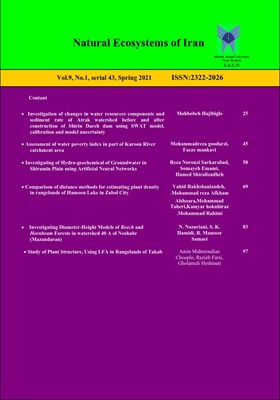Comparison of Distance Methods for Plants Density Estimation in Hamoon Lake Rangelands in Zabol
Subject Areas : ranglandVahid Rakhshanizade 1 * , mohamadreza saeid afkhamoshoara 2 , Zeinab Noori Kia 3 , mohamad taheri 4
1 - M.C
2 - Assistant Professor, Faculty of Natural Resources and Environmental Sciences, Birjand University
3 - Master of Natural Resource Office, Zahedan city.
4 - Master of Natural Resource Office, Zahedan city.
Keywords: Comparison of Plants, Cover Evaluation, Shrub Density, Plotless Method,
Abstract :
Density is one of the most important quantitative indicators in the study of rangelands and therefore it is necessary to choose the most appropriate method for measuring density in each area. Estimating the density of green seedlings in biological projects is also one of the concerns of supervising experts in these projects. Due to the fact that the study area is located in a desert environment have caused the vegetation to be resistant against drought and salinity and their vegetative form is often shrubs. Therefore, this research was done on fast-growing, evergreen, drought and salinity resistant species of Tamarix in three areas of annual planting. All the bases of Tamarix sp were counted in these three areas and in each area, 5 transects of 200 meters were placed parallel to each other and at a distance of 20 meters from each other and 10 points on each were identified as sampling points. This method was considered as a control. With the aim of comparing five distance methods including Closest Individual, Nearest Neighbor, Point-Centered Quarter, Quartered Neighbor and Angle Order in terms of accuracy in estimating the density of green seedlings of Tamarix species to introduce the method that provides the best accuracy in estimating the density of this species. The results show that in the area number one and three the Nearest Neighbor method and in area number two Quartered Neighbor method has the highest accuracy compared to the control.
_||_

